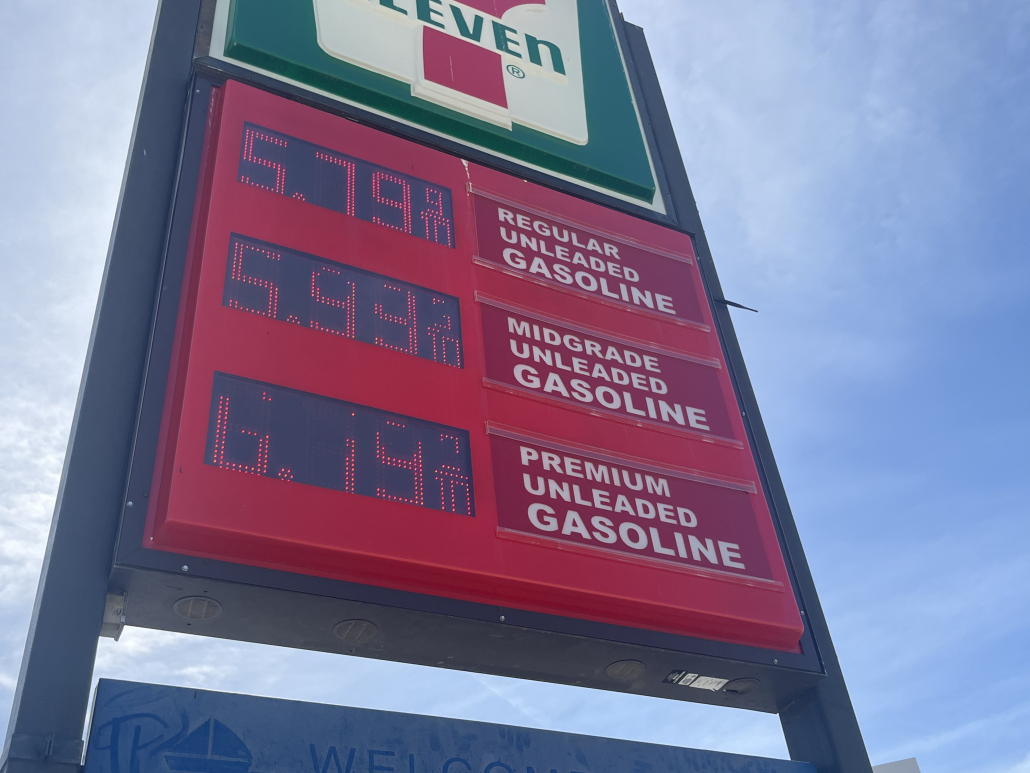Commuter students navigate gas prices

As gas prices skyrocket around the globe, commuter students like Ryan West have felt the holes in their pockets burn wider.
“I don’t really have much time to work,” West said. “So the rising gas costs just eat into what money I do have.”
West, a freshman majoring in mechanical engineering, commutes from Fullerton several times a week. For West, who spends anywhere from “30 minutes and two hours” sitting in traffic, the increases have forced him to change his transportation habits.
“With these prices, a half tank in my car is, I think, $30, and $60 for a full tank,” West said. “I’ve actually switched to riding a motorcycle as often as I can.”
The increase in gasoline prices comes from a variety of factors, including the declining coronavirus pandemic, record inflation and the recent conflict in Ukraine. The last time United States gas consumers faced similar surges in gas prices was during the 2008 financial crisis, where, after adjusting for inflation, gas averaged roughly $5.37 per gallon nationwide.
This year, oil suppliers have clambered to meet the new post-pandemic demand for a recovering economy. It was not until U.S. lawmakers laid down international sanctions on Russian exports, however, that prices soared, coinciding with worries about global supply.
Russia is one of the world’s premier exporters of oil, sending nearly eight million barrels of oil and other petroleum products to global markets in December. While the U.S. receives less than 10% of its oil from Russia, Europe gets upward of 60% and China another 20%. Since oil is priced on global commodity markets, the limitations on Russian oil affect prices around the world, regardless of its intended market.
Prices in California have stayed especially high even as national prices have started decreasing, with a new state average of $5.989 this week. California prices are naturally higher because of the state-mandated cleaner fuel blend, raising prices by 10 cents. But according to the New York Times, disruptions in the state supply chain have spurred bulk fuel prices to be upward of 80 to 90 cents higher per gallon than normal.
In response, commuter students, like West, have opted to decrease their expenses where they can, cutting back on the “nonessentials.”
The switch to motorcycling has also proved fruitful for West, who said he pushes upward of 45 to 60 miles per gallon while riding, even 110 in select circumstances. This is compared to the national average MPG of 25.7 for motor vehicles in 2020. West also said he is cutting back on weekly trips to campus.

Nilay Desai, who commutes from Culver City, echoed many of the same precautions as West in response to the high prices.
“‘I’m a bit more considerate of where I’m going out to eat and stuff like that,” said Desai, a junior majoring in human development and aging. “I’ve definitely been cooking at home more recently.”
While some in large cities have turned toward public transportation to reduce the financial strain, public transportation has proved largely ineffective in the Los Angeles area. Desai, who also works in the East L.A. Montebello area, said he found public transportation unable to meet his time-sensitive needs.
“I have to go out there [Montebello] and then I’ll come back to USC … It doesn’t really make sense to use public transportation in that kind of sense.”
West reiterated the same concerns, and said he’s considered public transportation, but for his schedule, it’s “not a viable option.”
Despite the high transportation costs, most have continued to shy away from Zoom offerings in exchange for in-person instruction.
“I could definitely see the advantage in that for certain classes,” West said, “But, in my opinion, for the most part, school is meant to be done in person.”
Amir Razipour, a senior majoring in health promotion and disease prevention, commutes from the Brentwood area and cited the high tuition fees against online alternatives.
“Each day we go to class, that’s almost a $500 expense given tuition,” Razipour said. “A $15 gas trip for me is kind of insignificant compared to the tuition we face.”
West also said he has concerns about the city as a whole, as increased demand has pushed prices even higher excluding gas.
“A lot of people travel far for work, namely L.A. commuters, and that’s why we get the rush hour traffic,” West said. “I definitely do think a lot of people are going to start considering what they can and can’t do, especially since a lot of people do live paycheck to paycheck.”

